Waves crashing over seafronts, hazardous 160-kilometre-an-hour winds and people scrambling for shelter from storm surges. During the second half of 2017, the Caribbean has been battered on all sides by extreme weather. Hurricane Irma – which ranked as one of the most powerful Atlantic storms on record – swiftly followed by José and Maria, wreaked havoc on the region, underlying the vulnerabilities tropical weather poses to Caribbean economies.
More from this report
By a combination of sheer luck and improvements to the country's infrastructure, the Dominican Republic is weathering the regional crisis.
With unprecedented climatic conditions come new worries about the resilience of existing buildings, but Ernesto Veloz, president of the Dominican Republic's East Zone Association of Hotels and Tourism Projects, says the hotel infrastructure of popular tourism region Punta Cana has not suffered “considerable” damage, with only the “usual minor impact you would face with […] rains of this nature”.
Property investors have taken note. “The appeal of the Dominican property market is the variety and sturdiness,” says Walter Zephirin of 7th Heaven Properties, which specialises in property sales across the Caribbean.
Top destination
Nature, it seems, has both blessed and cursed the Dominican Republic, and the country is reaping the benefits of the positive aspects.
Tourism represents roughly 17% of gross domestic product and the largest share of foreign direct investment (FDI) to the country. In 2016, it was worth $790m, one-third of the total $2.4bn inflows, up from $108m five years prior, according to figures from the Dominican Republic's central bank. This comfortably surpasses FDI volumes of real estate and mining, the second and third largest sectors by volume.
“Tourism in the Dominican Republic is a priority for everyone, and it shows,” says Alex Sozaya, CEO of US-based Apple Leisure Group, which owns 14 hotels in the country and has investments elsewhere in the region. “Investing in the Dominican Republic alongside local investors and local banks is a reality and it is more attractive than in most destinations in the Caribbean or Latin America.”
In 2016, the Dominican Republic was the largest recipient of FDI in the Caribbean, with $2.4bn-worth of investment, up 9% on 2015, according to the UN Conference on Trade and Development. As of the end of March this year, $688m had been received, predominantly from Canada, Mexico and the US.
Getting up to date
Tourism in the Dominican Republic continues to thrive: air and cruise visitor numbers reached 6.8 million in 2016, while hotel occupancy rates in the country currently hover at about 80%, an improvement of 18 percentage points on 2015. Vice-minister for tourism Radhamés Martínez Aponte publicly said this is largely due to the 5400 new rooms that became available in 2016. Established travel brands with existing projects in the country are subsequently renovating their hotels, upgrading their four-star resorts to five-star status to compete with new offerings.
The iconic Tortuga Bay Hotel in Punta Cana, designed by native fashion designer Oscar de la Renta, is a key example. It has been closed for a full overhaul of its 13 villas since July 2017 and is set to reopen in November.
A five-star Four Seasons hotel in the Tropicalia resort in the underdeveloped Miches area in the north of the country is currently under construction by the Cisneros Group, an international property empire with Venezuelan roots.
New developments are in line with the type of tourist the country attracts, say travel agencies; middle-income travellers who expect solid infrastructure and a certain level of personal safety.
Financial incentive
The Dominican Republic appeals from a cost perspective, too. Unlike other destinations in the Caribbean Sea, the price of a well-positioned apartment starts at about $300,000, says Mr Zephirin. On average the annual rental return ranges from 5% to 7% on a $400,000 property due to the level of tourism in the country. In its analysis of the Dominican Republic, rating agency Moody’s, which upgraded the sovereign risk to Ba3 this July, recognises the strength of the sector, particularly compared with other countries in the region, because it offers diverse options to visitors and is competitive on cost, according to analyst Ariane Ortiz-Bollin.
Greater numbers of tourists are also helping to support domestic consumption through employment. Demand for local housing is on the rise, most notably in the Las Terrenas and Punta Cana areas, where people work in the service sector. A further boost to the sector could come from Chinese tourists and investors, says Mr Zephirin, although China has failed to feature in the top 15 foreign investors for seven consecutive years, according to FDI figures from the Dominican central bank.
Competing with Cuba
But Chinese and other investors could be looking elsewhere. Proud Dominicans often boast that their beaches are better than those of their neighbour Cuba, but if US-Cuban relations improve following Raúl Castro’s decision not to seek re-election in 2018, increased Cuban access to US commercial and tourism markets will present competition for the Dominican Republic.
“There have been some policy concerns over how much of a competitor Cuba will become in the longer term,” says Kelli Bissett-Tom, associate director of Latin American sovereigns at Fitch Ratings. “But the difference is that the Dominican Republic has a larger population and the cost of labour tends to be lower given immigration from Haiti.”
In addition, the Dominican Republic has a more established reputation as a tourism destination than Cuba, says Ms Bissett-Tom. Given US president Donald Trump’s slight reversal in Cuba policy earlier this year, it is too early to predict the comparative attractiveness of two destinations. More cruise liners offering a Cuba stop-off on their itineraries could make the country an ally rather than a competitor, however.













